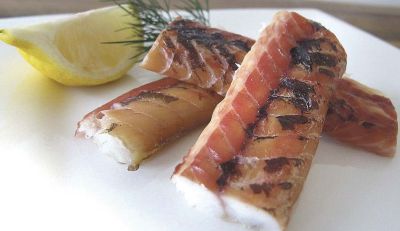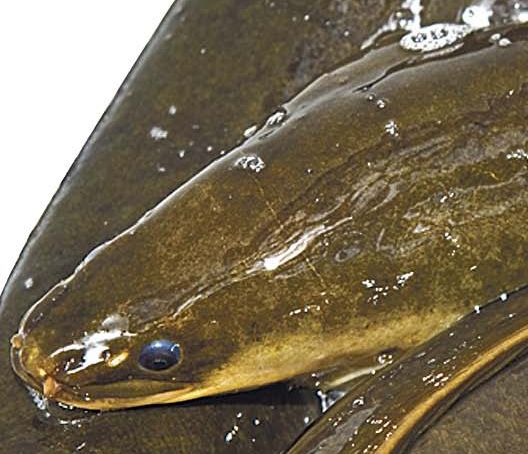From the Archives ...
Sea Trout Fishing - October and November
Sea Trout Fishing - October and November
Christopher Bassano
Fishing guide Christopher Bassano explores his favourite fishing-and shares a few tips that will help you discover the world of trout near the sea.
 Presented from Issue 113, December 2014
Presented from Issue 113, December 2014
While not hugely popular in Tasmania, smoked eel is considered a true delicacy in many countries. It is particularly popular throughout Eastern Europe where it is often sold at a premium price. While it is rare to encounter this type of smoked product in Tassie, I have seen it at a one of the seafood establishments on Hobart’s waterfront. The sale price was over $50 per kilogram. You may be asking yourself, why so expensive? At that price, it must taste amazing, right?
Well, the answer is yes, it is expensive, but the taste is something special!
In my opinion, hot-smoked eel tastes a bit like crayfish, with the added flavour of smoke. The flesh is oily, and it is similar in appearance to that of cooked cray flesh. The high natural oil content of eel makes it the perfect fish to smoke.
- Written by Stephen Smith - Rubicon Web and Technology Training
- Category: Eel
- Hits: 28262
Read more: Smoked Eel - A delicacy made in your back yard - Michal Rybka
 Presented from Issue 113, December 2014
Presented from Issue 113, December 2014
Aunique partnership between Hydro Tasmania, the Inland Fisheries Service (IFS) and professional eel fishermen is boosting the health of Tasmania’s inland waterways and the sustainability of the State’s growing commercial eel fishery.
Tasmania has the most predictable and high quality juvenile eel migrations within Australian waters, but 50 major dams built for the creation of hydroelectricity obstruct these upstream migrations. So IFS and Hydro Tasmania give hundreds of thousands of elvers (baby eels) a metaphorical leg up into the Hydro catchments and the eel fishers translocate as many more to other inland waters around the State.
The IFS annual elver harvesting and restocking programs support the wild fishery in Tasmania’s rivers and lakes, where eels are a vital part of the ecosystem as the only large, native, predatory fin fish. Hydro Tasmania has a responsibility for 53 of Tasmania’s major lakes and at least 1200 km of natural creeks and rivers are influenced by their operations in some way.
- Written by Stephen Smith - Rubicon Web and Technology Training
- Category: Eel
- Hits: 7245
Read more: Eel fishers - watchers of our trout waters - Simon de Salis
Current TFBN
Click above for current issue content. The current issue of TFBN is extensive and topical. In Tackle Stores, Newsagents and by subscription.
Delivered to your door for $48 for 2 years (8 issues). To subscribe, send Mike $48 via www.paypal.com.au . (Basic instructions are here) The email is at Contact Us. Your address will be included from PayPal.
Or phone Mike with your c/c handy on 0418129949
Please ensure your details are correct, for Mike to organise delivery.
TFBN Newsletter Sign up Form
Why not submit an article ?
When you have finished for the day, why not have a brag about the ones that didn't get away! Send Mike an article on your fishing (Click here for contact details), and we'll get it published here. Have fun fishing - tasfish.com
Category Descriptions
Here is a list of all of the Article Categories. The number in Brackets, eg (13) is the number of articles. Click on Derwent River and all articles relating to the Derwent will be displayed in the central area.
Articles by Category
-
Rivers (3)
-
Saltwater and Estuary Fishing (149)
-
Kayak Fishing (34)
-
Lakes (1)
-
Great Lake (62)
-
Lake Leake (52)
-
Woods Lake (16)
-
Lake Augusta (11)
-
Huntsman Lake (13)
-
Lake Pedder and Gordon (10)
-
Lake Dulverton (5)
-
Lake Crescent (6)
-
Tooms Lake (10)
-
Lake Mackintosh (2)
-
Lake Barrington (5)
-
Little Lake (8)
-
Meadowbank Lake (5)
-
Lake King William (7)
-
Lake St Clair (2)
-
Western Lakes (12)
-
Arthurs Lake (35)
-
Lake Echo (7)
-
Four Springs (54)
-
Lake Sorell (7)
-
Lake Burbury (6)
-
Other Lakes (57)
-
Brushy Lagoon (18)
-
Little Pine Lagoon (5)
-
Penstock Lagoon (16)
-
Brumbys Creek (7)
-
-
Events (48)
-
Estuary Fishing (0)
-
Coastal Catches (46)
-
Super Trawler (46)
-
IFS, DPIPWE, MAST and Peak Bodies (435)
-
Commercial Interests (98)
-
Other (24)
-
TFBN Back Issues (8)
-
Fly Fishing (67)
-
Trout Fishing (250)
-
Meteorology and Weather (8)
-
Jan’s Flies (50)
-
Tuna Fishing and other Game Fishing (86)
-
Cooking Fish (19)
-
Fishing Information (1)
-
Fishing Books (8)
-
Videos (5)
-
Tackle, Boats and other Equipment (146)
-
World Fly Fishing Championship 2019 (2)
Popular Tags
windyty.com
Visit https://www.windyty.com/
Rubicon Web and Technology Training
Hello everyone, I thought it would be a good time to introduce myself.
My name is Stephen Smith and I have been managing the website tasfish.com since May 2009.
It has been an epic journey of learning and discovery and I am indebted to Mike Stevens for his help, support and patience.
I am developing a new venture Rubicon Web and Technology Training ( www.rwtt.com.au ). The focus is two part, to develop websites for individuals and small business and to train people to effectively use technology in their everyday lives.
Please contact me via www.rwtt.com.au/contact-me/ for further information - Stephen Smith.
From the Archives ... (last chance)
Tiny creeks and sea run trout - Christopher Bassano
Presented from Issue 105, August 2013
Christopher Bassano fishes over 250 days a year. This interview was recorded just before he headed off to fish for Australia in the World Fly Fishing Championships in Norway 14-17 August 2013.
I live on a small stream and at the start of the season I like to go off on a bit of a discovery mission and fish the headwaters of the creeks and rivers I feel an affinity with.
These small rivers include the St Pats, Meander, Forester, Little Forester and others. The further up you go on these rivers the clearer and lower the levels. They are often less affected by the rain and runoff and you get some good opportunities. Get as close to the source as you can and you will find some good dry fly fishing. Don’t limit yourself to those I have mentioned. Most headwaters will hold trout.
Read more ...


